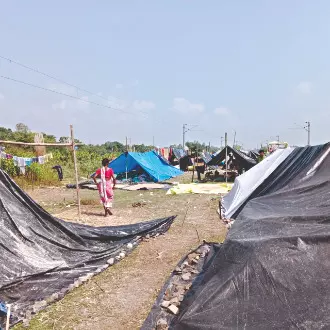Over 30,000 affected as floods ravage Jalpaiguri dist

Jalpaiguri: Severe flooding has wreaked havoc in Jalpaiguri district, affecting all eight blocks to varying degrees, with over 30,000 people impacted. The worst-hit areas include Nagrakata, Dhupguri, Mainaguri, and Kranti blocks, where the fury of rivers has left villages submerged and homes destroyed.
In Nagrakata, the Gathia River has devastated villages such as Tondu Basti and Hajipara, turning them into virtual ruins. Similar destruction is reported in Tarabari,
Khatorbari, and Kharibari under the Amguri Gram Panchayat of Mainaguri. In the Kranti block, 78 families in Saheb Bari and Dolaigaon remain stranded in the Changmari Tea Garden area.
The administration is working on a war footing to manage the crisis. Chief Minister Mamata Banerjee has provided financial assistance to the families of five people who died in Bamundanga after being swept away from Kalikhola near Luksan on Sunday. Relief operations are ongoing, with 16 camps currently operational and several community kitchens set up by the district police. District Superintendent of Police Khandbahale Umesh Ganpath said: “Our community kitchens are functioning, but many severely affected areas remain unreachable. Food is being delivered through civic volunteers.”
Infrastructure repairs are underway. The collapsed soil beneath railway tracks in Betgara has been restored, but train services under the Alipurduar Division of Northeast Frontier Railway are temporarily diverted via the Mathabhanga Y-channel. Medical teams and police help centers are active across flood-hit areas.
While floodwaters in Maynaguri and Kranti blocks have started to recede due to dry weather, many families remain displaced. In Changmari Gram Panchayat, 78 families are still stranded on embankments, and over 30 homes in Amguri Gram Panchayat have been destroyed.
Agricultural losses have been severe. Vast tracts of farmland in Maynaguri, Kranti, and Dhupguri blocks have been inundated, destroying nearly 2,000 hectares of Aman paddy and early winter vegetables.
Crops such as cauliflower, cabbage, pointed gourd, and radish have suffered significant damage. Maynaguri Block Agriculture officer Kamalesh Barman confirmed that the department is setting up camps to help farmers claim compensation under the Bangla Shasya Bima Yojana. In the Dhupguri block, around 650 hectares of paddy fields and 900 hectares of bean cultivation across several villages, including Godhearkuthi, Kurshamari, Bogribari, and Bhandani, have been damaged. Officials have urged farmers to prioritise crop insurance in the aftermath of the disaster.
The floods have also impacted wildlife. The Nature Interpretation Centre in Lataguri reports multiple animal carcasses, including wild boars, deer, bison, and one rhino, recovered from the Jaldhaka River. Rajib De, ADFO of Gorumara Wildlife Division, stated: “Some animals may still be hiding near villages, but there are no dangerous predators in the area.”
Tourism has taken a severe hit. Elephant safari paths, watchtowers, and forest trails in Gorumara have been submerged or damaged, forcing indefinite closure. Tourist bookings are being canceled as the area struggles to recover.



